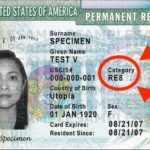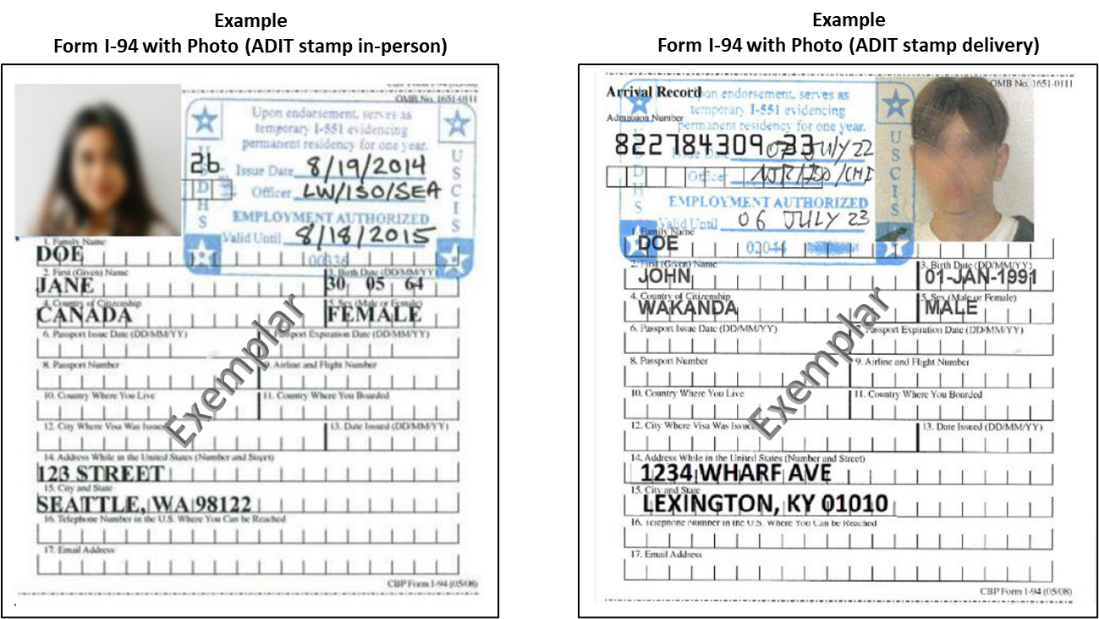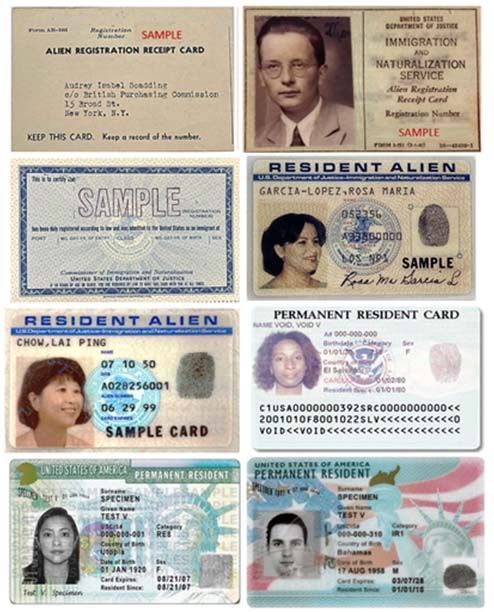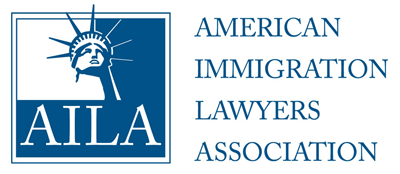List of Green Card Categories and What They Mean

What is a Green Card Category?
The Category or Code of a Green Card represents the lawful permanent resident’s (LPR’s) or conditional permanent resident’s (CR’s) class of admission.
The letter(s) indicates a broad category and the number(s) indicates the order and relationship in the category.
The Category can be found on the Lawful Permanent Resident Card (more commonly known as LPR Card or Green Card).
List of Green Card Categories:
A11 Unmarried Amerasian son or daughter of a U.S. citizen born in Cambodia, Korea, Laos, Thailand, or Vietnam. Sec. 203(a)(1) of the INA and 204(g) as added by PL-97-359 (Oct. 22, 1982)- ((entered with IV))
A12 Child of an alien classified as A11 or A16. Sec. 203(d) of the INA and 204(g) as added by PL-97-359 (Oct. 22, 1982) – ((entered with IV))
A16 Unmarried Amerasian son or daughter of a U.S. citizen born in Cambodia, Korea, Laos, Thailand, or Vietnam. Sec. 203(a)(1) of the INA and 204(g) as added by PL-97-359 (Oct. 22, 1982) – ((Adjusted status))
A17 Child of an alien classified as A11 or A16. Sec. 203(d) of the INA and 204(g) as added by PL-97-359 (Oct. 22, 1982) – ((Adjusted status))
A31 Married Amerasian son or daughter of a U.S. citizen born in Cambodia, Korea, Laos, Thailand, or Vietnam. Sec. 203(a)(3) of the INA and 204(g) as added by PL-97-359 (Oct. 22, 1982) – ((entered with IV))
A32 Spouse of an alien classified as A31 or A36. Sec. 203(d) of the INA and 204(g) as added by PL-97-359 (Oct. 22, 1982) – ((entered with IV))
A33 Child of an alien classified as A31 or A36. Sec. 203(d) of the INA and 204(g) as added by PL-97-359 (Oct. 22, 1982) – ((entered with IV))
A36 Married Amerasian son or daughter of a U.S. citizen born in Cambodia, Korea, Laos, Thailand, or Vietnam. Sec. 203(a)(3) of the INA and 204(g) as added by PL-97-359 (Oct. 22, 1982) – ((Adjusted status))
A37 Spouse of an alien classified as A31 or A36. Sec. 203(d) of the INA and 204(g) as added by PL-97-359 (Oct. 22, 1982) – ((Adjusted status))
A38 Child of an alien classified as A31 or A36. Sec. 203(d) of the INA and 204(g) as added by PL-97-359 (Oct. 22, 1982) – ((Adjusted status))
AA1 Native of certain adversely affected foreign states (Diversity Transition). Sec. 132 of PL-101-649 (Nov. 29, 1990) – ((entered with IV))
AA2 Spouse of an alien classified as AA1 or AA6. Sec. 132 of PL-101-649 (Nov. 29, 1990) – ((entered with IV))
AA3 Child of an alien classified as AA1 or AA6. Sec. 132 of PL-101-649 (Nov. 29, 1990) – ((entered with IV))
AA6 Native of certain adversely affected foreign states (Diversity Transition). Sec. 132 of PL-101-649 (Nov. 29, 1990) – ((Adjusted status))
AA7 Spouse of an alien classified as AA1 or AA6. Sec. 132 of PL-101-649 (Nov. 29, 1990) – ((Adjusted status))
AA8 Child of an alien classified as AA1 or AA6. Sec. 132 of PL-101-649 (Nov. 29, 1990) – ((Adjusted status))
AM1 Amerasian born in Vietnam after Jan. 1, 1962 and before Jan. 1, 1976, who was fathered by a U.S. citizen. Sec. 584(b)(1)(- ((Adjusted status))) of PL-100-202 (Dec. 22, 1987) – ((entered with IV))
AM2 Spouse or child of an alien classified as AM1 or AM6. Sec. 584(b)(1)(B) of PL-100-202 (Dec. 22, 1987) – ((entered with IV))
AM3 Mother, guardian, or next-of-kin of an alien classified as AM1 or AM6, and spouse/child of the mother, guardian, or next-of-kin. Sec. 584(b)(1)(C) of PL-100-202 (Dec. 22, 1987) – ((entered with IV))
AM6 Amerasian born in Vietnam after Jan. 1, 1962 and before Jan. 1, 1976, who was fathered by a U.S. citizen. Sec. 584(b)(1)(- ((Adjusted status))) of PL-100-202 (Dec. 22, 1987) – ((Adjusted status))
AM7 Spouse or child of an alien classified as AM1 or AM6. Sec. 584(b)(1)(B) of PL-100-202 (Dec. 22, 1987) – ((Adjusted status))
AM8 Mother, guardian, or next-of-kin of an alien classified as AM1 or AM6, and spouse/child of the mother, guardian, or next-of-kin. Sec. 584(b)(1)(C) of PL-100-202 (Dec. 22, 1987) – ((Adjusted status))
AR1 Amerasian child of a U.S. citizen born in Cambodia, Korea, Laos, Thailand, or Vietnam (immediate relative child). Sec. 201(b)(2)(- ((Adjusted status)))(i) of the INA and 204(g) as added by PL-97-359 (Oct. 22, 1982) – ((entered with IV))
AR6 Amerasian child of a U.S. citizen born in Cambodia, Korea, Laos, Thailand, or Vietnam (immediate relative child). Sec. 201(b)(2)(A)(i) of the INA and 204(g) as added by PL-97-359 (Oct. 22, 1982) – ((Adjusted status))
AS6 Asylee principal. Sec. 209(b) of the INA as added by PL-96- 212 (Mar. 17, 1980) – ((Adjusted status))
AS7 Spouse of an alien classified as AS6. Sec. 209(b) of the INA as added by PL-96- 212 (Mar. 17, 1980) – ((Adjusted status))
AS8 Child of an alien classified as AS6. Sec. 209(b) of the INA as added by PL-96-212 (Mar. 17, 1980) – ((Adjusted status))
B11 Self-petition unmarried son/daughter of U.S. citizen. Sec. 40701 of PL-103-322 (Sept. 13, 1994) – ((entered with IV))
B12 Child of an alien classified as B11 or B16. Sec. 40701 of PL-103-322 (Sept. 13, 1994) – ((entered with IV))
B16 Self-petition unmarried son/daughter of U.S. citizen. Sec. 40701 of PL-103-322 (Sept. 13, 1994) – ((Adjusted status))
B17 Child of an alien classified as B11 or B16. Sec. 40701 of PL-103-322 (Sept. 13, 1994) – ((Adjusted status))
B20 Child of an alien classified as B24 or B29. Sec. 40701 of PL-103-322 (Sept. 13, 1994) – ((Adjusted status))
B21 Self-petition spouse of legal permanent resident. Sec. 40701 of PL-103-322 (Sept. 13, 1994) – ((entered with IV))
B22 Self-petition child of legal permanent resident. Sec. 40701 of PL-103-322 (Sept. 13, 1994) – ((entered with IV)) FY 2000
B23 Child of an alien classified as B21, B22, B26, or B27.Sec. 40701 of PL-103-322 (Sept. 13, 1994) – ((entered with IV))
B24 Self-petition unmarried son/daughter of legal permanent resident. Sec. 40701 of PL-103-322 (Sept. 13, 1994) – ((entered with IV))
B25 Child of an alien classified as B24 or B29. Sec. 40701 of PL-103-322 (Sept. 13, 1994) – ((entered with IV))
B26 Self-petition spouse of legal permanent resident. Sec. 40701 of PL-103-322 (Sept. 13, 1994) – ((Adjusted status))
B27 Self-petition child of legal permanent resident. Sec. 40701 of PL-103-322 (Sept. 13, 1994) – ((Adjusted status))
B28 Child of an alien classified as B21, B22, B26, or B27. Sec. 40701 of PL-103-322 (Sept. 13, 1994) – ((Adjusted status))
B29 Self-petition unmarried son/daughter of legal permanent resident. Sec. 40701 of PL-103-322 (Sept. 13, 1994) – ((Adjusted status))
B31 Self-petition married son/daughter of U.S. citizen. Sec. 40701 of PL-103-322 (Sept. 13, 1994) – ((entered with IV))
B32 Spouse of an alien classified as B31 or B36. Sec. 40701 of PL-103-322 (Sept. 13, 1994) – ((entered with IV))
B33 Child of an alien classified as B31 or B36. Sec. 40701 of PL-103-322 (Sept. 13, 1994) – ((entered with IV))
B36 Self-petition married son/daughter of U.S. citizen. Sec. 40701 of PL-103-322 (Sept. 13, 1994) – ((Adjusted status))
B37 Spouse of an alien classified as B31 or B36. Sec. 40701 of PL-103-322 (Sept. 13, 1994) – ((Adjusted status))
B38 Child of an alien classified as B31 or B36. Sec. 40701 of PL-103-322 (Sept. 13, 1994) – ((Adjusted status))
BC1 Alien entering the United States to work as broadcaster or for a grantee for the IBCB of BBG Sec. 101(a)(27) of the INA as added by PL-106-536 (Nov. 22, 2000) International Broadcasting Bureau of the Broadcasting Board of Governors (IBCB of BBG) – ((entered with IV)) FY 2001
BC2 (IBCB of BBG) Spouse of BC1 Sec. 101(a)(27) of the INA as added by PL-106- 536 Nov. 22, 2000)International Broadcasting Bureau of the Broadcasting Board of Governors (IBCB of BBG) – ((entered with IV)) FY 2001
BC3 ( IBCB of BBG) Child of BC1 Sec. 101(a)(27) of the INA as added by PL-106- 536 Nov. 22, 2000)International Broadcasting Bureau of the Broadcasting Board of Governors (IBCB of BBG) – ((entered with IV)) FY 2001
BC6 Alien entering the United States to work as broadcaster or for a grantee for the IBCB of BBG Sec. 101(a)(27) of the INA as added by PL-106- 536 (Nov. 22, 2000) International Broadcasting Bureau of the Broadcasting Board of Governors (IBCB of BBG) – ((Adjusted status)) FY 2001
BC7 (IBCB of BBG) Spouse of BC6 Sec. 101(a)(27) of the INA as added by PL-106- 536 Nov. 22, 2000) International Broadcasting Bureau of the Broadcasting Board of Governors (IBCB of BBG) – ((Adjusted status)) FY 2001
BC8 (IBCB of BBG) Child of BC6 Sec. 101(a)(27) of the INA as added by PL-106- 536 Nov. 22, 2000) International Broadcasting Bureau of the Broadcasting Board of Governors (IBCB of BBG) – ((Adjusted status)) FY 2001
BX1 Self-petition spouse of legal permanent resident – exempt. Sec. 40701 of PL-103-322 (Sept. 13, 1994) – ((entered with IV))
BX2 Self-petition child of legal permanent resident – exempt. Sec. 40701 of PL-103-322 (Sept. 13, 1994) – ((entered with IV))
BX3 Child of an alien classified as BX1, BX2, BX6, or BX7. Sec. 40701 of PL-103-322 (Sept. 13, 1994) – ((entered with IV))
BX6 Self-petition spouse of legal permanent resident – exempt. Sec. 40701 of PL-103-322 (Sept. 13, 1994) – ((Adjusted status))
BX7 Self-petition child of legal permanent resident – exempt. Sec. 40701 of PL-103-322 (Sept. 13, 1994) – ((Adjusted status))
BX8 Child of an alien classified as BX1, BX2, BX6, or BX7. Sec. 40701 of PL-103-322 (Sept. 13, 1994) – ((Adjusted status))
C20 Child of an alien classified as C24 or C29 – conditional. Sec. 203(d) of the INA and 216 as added by PL-99-639 (Nov. 10, 1986) – ((Adjusted status))
C21 Spouse of a lawful permanent resident alien (subject to country limitations) – conditional. Sec. 203(a)(2)(- ((Adjusted status))) of the INA and 216 as added by PL-99-639 (Nov. 10, 1986) – ((entered with IV))
C22 Step-child (under 21 years of age) of a lawful permanent resident alien (subject to country limitations) – conditional. Sec. 203(a)(2)(- ((Adjusted status))) of the INA and 216 as added by PL-99-639 (Nov. 10, 1986) – ((entered with IV))
C23 Child of an alien classified as C21, C22, C26, or C27 (subject to country limitations) – conditional. Sec. 203(d) of the INA and 216 as added by PL-99-639 (Nov. 10, 1986) – ((entered with IV))
C24 Unmarried son or daughter (21 years of age or older) who is a step-child of a lawful permanent resident alien (subject to country limitations) – conditional. Sec. 203(a)(2)(B) of the INA and 216 as added by PL-99-639 (Nov. 10, 1986) – ((entered with IV))
C25 Child of an alien classified as C24 or C29 – conditional. Sec. 203(d) of the INA and 216 as added by PL-99-639 (Nov. 10, 1986) – ((entered with IV))
C26 Spouse of a lawful permanent resident alien (subject to country limitations) – conditional. Sec. 203(a)(2)(- ((Adjusted status))) of the INA and 216 as added by PL-99-639 (Nov. 10, 1986) – ((Adjusted status))
C27 Step-child (under 21 years of age) of a lawful permanent resident alien (subject to country limitations) – conditional. Sec. 203(a)(2)(- ((Adjusted status))) of the INA and 216 as added by PL-99-639 (Nov. 10, 1986) – ((Adjusted status))
C28 Child of an alien classified as C21, C22, C26, or C27 (subject to country limitations) – conditional. Sec. 203(d) of the INA and 216 as added by PL-99-639 (Nov. 10, 1986)
C29 Unmarried son or daughter (21 years of age or older) who is a step-child of a lawful permanent resident alien (subject to country limitations) -conditional. Sec. 203(a)(2)(B) of the INA and 216 as added by PL-99-639 (Nov. 10, 1986) – ((Adjusted status))
C31 Married son or daughter who is a step-child of a U.S. citizen – conditional. Sec. 203(a)(3) of the INA and 216 as added by PL-99-639 (Nov. 10, 1986) – ((entered with IV))
C32 Spouse of an alien classified as C31 or C36 -conditional. Sec. 203(d) of the INA and 216 as added by PL-99-639 (Nov. 10, 1986) – ((entered with IV))
C33 Child of an alien classified as C31 or C36 -conditional. Sec. 203(d) of the INA and 216 as added by PL-99-639 (Nov. 10, 1986) – ((entered with IV))
C36 Married son or daughter who is a step-child of a U.S. citizen – conditional. Sec. 203(a)(3) of the INA and 216 as added by PL-99-639 (Nov. 10, 1986) – ((Adjusted status))
C37 Spouse of an alien classified as C31 or C36 – conditional. Sec. 203(d) of the INA and 216 as added by PL-99-639 (Nov. 10, 1986) – ((Adjusted status))
C38 Child of an alien classified as C31 or C36 -conditional. Sec. 203(d) of the INA and 216 as added by PL-99-639 (Nov. 10, 1986) – ((Adjusted status))
C51 Employment creation immigrant (not in targeted area) – conditional. Sec. 203(b)(5)(- ((Adjusted status))) of the INA – ((entered with IV))
C52 Spouse of an alien classified as C51 or C56 (not in targeted area) – conditional. Sec. 203(d) of the INA – ((entered with IV))
C53 Child of an alien classified as C51 or C56 (not in targeted area) – conditional. Sec. 203(d) of the INA – ((entered with IV))
C56 Employment creation immigrant (not in targeted area) – conditional. Sec. 203(b)(5)(- ((Adjusted status))) of the INA – ((Adjusted status))
C57 Spouse of an alien classified as C51 or C56 (not in targeted area) – conditional. Sec. 203(d) of the INA – ((Adjusted status))
C58 Child of an alien classified as C51 or C56 (not in targeted area) – conditional. Sec. 203(d) of the INA – ((Adjusted status))
CB1 Spouse of an alien granted legalization under Sections 210, 245A of the INA, or Sec. 202 of PL-99-603 (Cuban-Haitian entrant) – conditional. Sec. 112 of PL-101-649 (Nov. 29, 1990) and 216 as added by PL-99-639 (Nov. 10, 1986) – ((entered with IV))
CB2 Child of alien granted legalization under Sections 210, 245A of the INA, or Sec. 202 of PL-99-603 (Cuban-Haitian entrant) -conditional. Sec. 112 of PL-101-649 (Nov. 29, 1990) and 216 as added by PL-99-639 (Nov. 10, 1986) – ((entered with IV))
CB6 Spouse of an alien granted legalization under Sections 210, 245A of the INA, or Sec. 202 of PL-99-603 (Cuban-Haitian entrant) – conditional. Sec. 112 of PL-101-649 (Nov. 29, 1990) and 216 as added by PL-99-639 (Nov. 10, 1986) – ((Adjusted status))
CB7 Child of alien granted legalization under Sections 210, 245A of the INA, or Sec. 202 of PL-99-603 (Cuban-Haitian entrant) -conditional. Sec. 112 of PL-101-649 (Nov. 29, 1990) and 216 as added by PL-99-639 (Nov. 10, 1986) – ((Adjusted status)) FY 2000
CF1 Alien whose record of admission is created upon the conclusion of a valid marriage contract after entering as a fiance or fiancée of a U.S. citizen -conditional. Sec. 214(d) of the INA and 216 as added by PL-99-639 (Nov. 10, 1986) – ((Adjusted status))
CF2 Minor step-child of an alien classified as CF1 -conditional. Sec. 214(d) of the INA and 216 as added by PL-99-639 (Nov. 10, 1986) – ((Adjusted status))
CH6 Cuban-Haitian entrant. Sec. 202 of PL-99-603 (Nov. 6, 1986) – ((Adjusted status))
CR1 Spouse of a U.S. citizen – conditional. Sec. 201(b)(2)(- ((Adjusted status)))(i) of the INA and 216 as added by PL-99-639 (Nov. 10, 1986) – ((entered with IV))
CR2 Step-child of a U.S. citizen – conditional. Sec. 201(b)(2)(- ((Adjusted status)))(i) of the INA and 216 as added by PL-99-639 (Nov. 10, 1986) – ((entered with IV))
CR6 Spouse of a U.S. citizen – conditional. Sec. 201(b)(2)(- ((Adjusted status)))(i) of the INA and 216 as added by PL-99-639 (Nov. 10, 1986)- ((Adjusted status))
CR7 Step-child of a U.S. citizen – conditional. Sec. 201(b)(2)(- ((Adjusted status)))(i) of the INA and 216 as added by PL-99-639 (Nov. 10, 1986) – ((Adjusted status))
CU6 Cuban refugee. Sec. 1 of PL-89-732 (Nov. 2, 1966) as amended by PL-94-571 (Oct. 20, 1976) – ((Adjusted status))
CU7 Non-Cuban spouse/child of an alien classified as a CU6.Sec. 1 of PL-89-732 (Nov. 2, 1966) as amended by PL-94-571 (Oct. 20, 1976) – ((Adjusted status))
CX1 Spouse of a lawful permanent resident alien(exempt from country limitations)- conditional. Sec. 203(a)(2)(- ((Adjusted status))) of the INA and 216 as added by PL-99-639 (Nov. 10, 1986) – ((entered with IV))
CX2 Step-child (under 21 years of age) of a lawful permanent resident alien (exempt from country limitations) – conditional. Sec. 203(a)(2)(- ((Adjusted status))) of the INA and 216 as added by PL-99-639 (Nov. 10, 1986) – ((entered with IV))
CX3 Child of an alien classified as CX2 or CX7 (exempt from country limitations) – conditional. Sec. 203(d) of the INA and 216 as added by PL-99-639 (Nov. 10, 1986) – ((entered with IV))
CX6 Spouse of a lawful permanent resident alien(exempt from country limitations)- conditional. Sec. 203(a)(2)(- ((Adjusted status))) of the INA and 216 as added by PL-99-639 (Nov. 10, 1986) – ((Adjusted status))
CX7 Step-child (under 21 years of age) of a lawful permanent resident alien (exempt from country limitations) – conditional. Sec. 203(a)(2)(- ((Adjusted status))) of the INA and 216 as added by PL-99-639 (Nov. 10, 1986) – ((Adjusted status))
CX8 Child of an alien classified as CX2 or CX7 (exempt from country limitations) – conditional. Sec. 203(d) of the INA and 216 as added by PL-99-639 (Nov. 10, 1986) – ((Adjusted status))
DS1 Creation of a record of lawful permanent resident status for individuals born under diplomatic status in the United States. 8 CFR 101.3 as revised effective Feb. 10, 1982 (Federal Register, Vol. 47, p. 940: Jan. 8, 1982) – ((Adjusted status))
DT1 Natives of Tibet who have continuously resided in Nepal or India (Displaced Tibetan). Sec. 134 of PL-101-649 (Nov. 29, 1990) – ((entered with IV))
DT2 Spouse of an alien classified as DT1 or DT6. Sec. 134 of PL-101-649 (Nov. 29, 1990) – ((entered with IV))
DT3 Child of an alien classified as DT1 or DT6. Sec. 134 of PL-101-649 (Nov. 29, 1990) – ((entered with IV))
DT6 Natives of Tibet who have continuously resided in Nepal or India (Displaced Tibetan). Sec. 134 of PL-101-649 (Nov. 29, 1990) – ((Adjusted status))
DT7 Spouse of an alien classified as DT1 or DT6. Sec. 134 of PL-101-649 (Nov. 29, 1990) – ((Adjusted status))
DT8 Child of an alien classified as DT1 or DT6. Sec. 134 of PL-101-649 (Nov. 29, 1990) – ((Adjusted status))
DV1 Diversity immigrant. Sec. 201 and 203(c) of the INA as amended by PL-101-649 (Nov. 29, 1990) – ((entered with IV))
DV2 Spouse of an alien classified as DV1 or DV6. Sec. 201 and 203(c) of the INA as amended by PL-101-649 (Nov. 29, 1990) – ((entered with IV))
DV3 Child of an alien classified as DV1 or DV6. Sec. 201 and 203(c) of the INA as amended by PL-101-649 (Nov. 29, 1990) – ((entered with IV))
DV6 Diversity immigrant. Sec. 201 and 203(c) of the INA as amended by PL-101-649 (Nov. 29, 1990) – ((Adjusted status))
DV7 Spouse of an alien classified as DV1 or DV6. Sec. 201 and 203(c) of the INA as amended by PL-101-649 (Nov. 29, 1990) – ((Adjusted status))
DV8 Child of an alien classified as DV1 or DV6. Sec. 201 and 203(c) of the INA as amended by PL-101-649 (Nov. 29, 1990) – ((Adjusted status))
E10 Child of a priority worker classified as E11, E16,E12, E17, E13, or E18.Sec. 203(d) of the INA – ((Adjusted status))
E11 Priority worker – alien with extraordinary ability. Sec. 203(b)(1)(- ((Adjusted status))) of the INA – ((entered with IV))
E12 Priority worker – outstanding professor or researcher. Sec. 203(b)(1)(B) of the INA – ((entered with IV))
E13 Priority worker – certain multinational executive or manager. Sec. 203(b)(1)(C) of the INA – ((entered with IV))
E14 Spouse of a priority worker classified as E11,E16, E12, E17, E13, or E18.Sec. 203(d) of the INA – ((entered with IV))
E15 Child of a priority worker classified as E11, E16,E12, E17, E13, or E18.Sec. 203(d) of the INA – ((entered with IV))
E16 Priority worker – alien with extraordinary ability. Sec. 203(b)(1)(- ((Adjusted status))) of the INA – ((Adjusted status))
E17 Priority worker – outstanding professor or researcher. Sec. 203(b)(1)(B) of the INA – ((Adjusted status))
E18 Priority worker – certain multinational executive or manager. Sec. 203(b)(1)(C) of the INA – ((Adjusted status))
E19 Spouse of a priority worker classified as E11,E16, E12, E17, E13, or E18.Sec. 203(d) of the INA – ((Adjusted status))
E21 Professional holding an advanced degree or of exceptional ability. Sec. 203(b)(2) of the INA – ((entered with IV))
E22 Spouse of an alien classified as E21 or E26. Sec. 203(d) of the INA – ((entered with IV))
E23 Child of an alien classified as E21 or E26. Sec. 203(d) of the INA – ((entered with IV))
E26 Professional holding an advanced degree or of exceptional ability. Sec. 203(b)(2) of the INA – ((Adjusted status))
E27 Spouse of an alien classified as E21 or E26. Sec. 203(d) of the INA – ((Adjusted status))
E28 Child of an alien classified as E21 or E26. Sec. 203(d) of the INA – ((Adjusted status))
E30 Child of a skilled worker or professional classified as E31, E36, E32, or E37. Sec. 203(d) of the INA – ((Adjusted status))
E31 Alien who is a skilled worker. Sec. 203(b)(3)(- ((Adjusted status)))(i) of the INA – ((entered with IV))
E32 Professional who holds a baccalaureate degree or who is a member of a profession. Sec. 203(b)(3)(- ((Adjusted status)))(ii) of the INA – ((entered with IV))
E34 Spouse of a skilled worker or professional classified as E31, E36, E32, or E37. Sec. 203(d) of the INA – ((entered with IV))
E35 Child of a skilled worker or professional classified as E31, E36, E32, or E37. Sec. 203(d) of the INA – ((entered with IV))
E36 Alien who is a skilled worker. Sec. 203(b)(3)(- ((Adjusted status)))(i) of the INA – ((Adjusted status))
E37 Professional who holds a baccalaureate degree or who is a member of a profession. Sec. 203(b)(3)(- ((Adjusted status)))(ii) of the INA – ((Adjusted status))
E39 Spouse of a skilled worker or professional classified as E31, E36, E32, or E37. Sec. 203(d) of the INA – ((Adjusted status))
E51 Employment creation immigrant. Sec. 203(b)(5)(- ((Adjusted status))) of the INA – ((entered with IV))
E52 Spouse of an alien classified as E51 or E56. Sec. 203(d) of the INA – ((entered with IV))
E53 Child of an alien classified as E51 or E56. Sec. 203(d) of the INA – ((entered with IV))
E56 Employment creation immigrant. Sec. 203(b)(5)(- ((Adjusted status))) of the INA – ((Adjusted status))
E57 Spouse of an alien classified as E51 or E56. Sec. 203(d) of the INA – ((Adjusted status))
E58 Child of an alien classified as E51 or E56. Sec. 203(d) of the INA – ((Adjusted status))
EC6 Alien covered by Chinese Student Protection Act. Sec. 245 as amended by PL-101-649 (Nov. 29, 1990) and PL-102-404 (Oct. 9, 1992) – ((Adjusted status))
EC7 Spouse of alien covered by Chinese Student Protection Act. Sec. 245 as amended by PL-101-649 (Nov. 29, 1990) and PL-102-404 (Oct. 9, 1992) – ((Adjusted status))
EC8 Child of alien covered by Chinese Student Protection Act. Sec. 245 as amended by PL-101-649 (Nov. 29, 1990) and PL-102-404 (Oct. 9, 1992) – ((Adjusted status))
ES1 Soviet scientist, principal. Sec. 203(b)(2) of the INA as amended by Sec. 4 of PL-102-509 (Oct. 24, 1992) – ((entered with IV))
ES6 Soviet scientist, principal. Sec. 203(b)(2) of the INA as amended by Sec. 4 of PL-102-509 (Oct. 24, 1992) – ((Adjusted status))
EW0 Child of an alien classified as EW3 or EW8. Sec. 203(d) of the INA – ((Adjusted status))
EW3 Other worker performing unskilled labor, not of a temporary or seasonal nature, for which qualified workers are not available in the United Sec. 203(b)(3)(A0(iii) of the INA – ((entered with IV))
EW4 Spouse of an alien classified as EW3 or EW8. Sec. 203(d) of the INA – ((entered with IV))
EW5 Child of an alien classified as EW3 or EW8. Sec. 203(d) of the INA – ((entered with IV))
EW8 Other worker performing unskilled labor, not of a temporary or seasonal nature, for which qualified workers are not available in the United Sec. 203(b)(3)(A)(iii) of the INA – ((Adjusted status))
EW9 Spouse of an alien classified as EW3 or EW8. Sec. 203(d) of the INA – ((Adjusted status))
F11 Unmarried son or daughter of a U.S. citizen. Sec. 203(a)(1) of the INA – ((entered with IV))
F12 Child of an alien classified as F11 or F16. Sec. 203(d) of the INA – ((entered with IV))
F16 Unmarried son or daughter of a U.S. citizen. Sec. 203(a)(1) of the INA – ((Adjusted status))
F17 Child of an alien classified as F11 or F16. Sec. 203(d) of the INA – ((Adjusted status))
F20 Child of an alien classified as F24 or F29 (subject to country limitations). Sec. 203(d) of the INA – ((Adjusted status))
F21 Spouse of a lawful permanent resident alien (subject to country limitations). Sec. 203(a)(2)(- ((Adjusted status))) of the INA – ((entered with IV))
F22 Child (under 21 years of age) of a lawful permanent resident alien (subject to country limitations). Sec. 203(a)(2)(- ((Adjusted status))) of the INA – ((entered with IV))
F23 Child of an alien classified as F21 or F26 (subject to country limitations). Sec. 203(d) of the INA – ((entered with IV))
F24 Unmarried son or daughter (21 years of age or older) of a lawful permanent resident alien (subject to country limitations). Sec. 203(a)(2)(B) of the INA – ((entered with IV))
F25 Child of an alien classified as F24 or F29 (subject to country limitations). Sec. 203(d) of the INA – ((entered with IV))
F26 Spouse of a lawful permanent resident alien (subject to country limitations). Sec. 203(a)(2)(- ((Adjusted status))) of the INA – ((Adjusted status))
F27 Child (under 21 years of age) of a lawful permanent resident alien (subject to country limitations). Sec. 203(a)(2)(- ((Adjusted status))) of the INA – ((Adjusted status))
F28 Child of an alien classified as F21 or F26 (subject to country limitations). Sec. 203(d) of the INA – ((Adjusted status))
F29 Unmarried son or daughter (21 years of age or older) of a lawful permanent resident alien (subject to country limitations). Sec. 203(a)(2)(B) of the INA – ((Adjusted status))
F31 Married son or daughter of a U.S. citizen. Sec. 203(a)(3) of the INA – ((entered with IV))
F32 Spouse of an alien classified as F31 or F36. Sec. 203(d) of the INA – ((entered with IV))
F33 Child of an alien classified as F31 or F36. Sec. 203(d) of the INA – ((entered with IV))
F36 Married son or daughter of a U.S. citizen. Sec. 203(a)(3) of the INA – ((Adjusted status))
F37 Spouse of an alien classified as F31 or F36. Sec. 203(d) of the INA – ((Adjusted status))
F38 Child of an alien classified as F31 or F36. Sec. 203(d) of the INA – ((Adjusted status))
F41 Brother or sister of a U.S. citizen. Sec. 203(a)(4) of the INA – ((entered with IV))
F42 Spouse of an alien classified as F41 or F46. Sec. 203(d) of the INA – ((entered with IV))
F43 Child of an alien classified as F41 or F46. Sec. 203(d) of the INA – ((entered with IV))
F46 Brother or sister of a U.S. citizen. Sec. 203(a)(4) of the INA – ((Adjusted status))
F47 Spouse of an alien classified as F41 or F46. Sec. 203(d) of the INA – ((Adjusted status))
F48 Child of an alien classified as F41 or F46. Sec. 203(d) of the INA – ((Adjusted status))
FX1 Spouse of a lawful permanent resident alien (exempt from country limitations). Sec. 203(a)(2)(- ((Adjusted status))) and 202(a)(4)(- ((Adjusted status))) of the INA – ((entered with IV))
FX2 Child (under 21 years of age) of a lawful permanent resident alien (exempt from country limitations). Sec. 203(a)(2)(- ((Adjusted status))) and 202(a)(4)(- ((Adjusted status))) of the INA – ((entered with IV))
FX3 Child of an alien classified as FX1, FX2, FX7, or FX8 (exempt from country limitations). Sec. 203(d) and 202(a)(4)(- ((Adjusted status))) of the INA – ((entered with IV))
FX6 Spouse of a lawful permanent resident alien (exempt from country limitations). Sec. 203(a)(2)(- ((Adjusted status))) and 202(a)(4)(- ((Adjusted status))) of the INA – ((Adjusted status))
FX7 Child (under 21 years of age) of a lawful permanent resident alien (exempt from country limitations). Sec. 203(a)(2)(- ((Adjusted status))) and 202(a)(4)(- ((Adjusted status))) of the INA – ((Adjusted status))
FX8 Child of an alien classified as FX1, FX2, FX7, orFX8 (exempt from country limitations). Sec. 203(d) and 202(a)(4)(- ((Adjusted status))) of the INA – ((Adjusted status))
GA6 Iraqi National – whose application for asylum was processed in Guam between September 1,1996 and April 30, 1997, adjusting to lawful permanent residence in the U.S. Sec. 128 of PL-105-277 (Oct. 20, 1998) – ((Adjusted status))
GA7 Spouse of GA6 Sec. 128 of PL-105-277 (Oct. 20, 1998) – ((Adjusted status))
GA8 Child of GA6 Sec. 128 of PL-105-277 (Oct. 20, 1998) – ((Adjusted status))
HA6 Haitian National adjusting status under the Haitian Refugee Fairness Act of 1998 Sec. 902(b)(1)(- ((Adjusted status))) of PL-105-277. Haitian Refugee Immigration Fairness Act (HRIFA Oct. – ((Adjusted status)) FY 1999
HA7 Spouse of HA6. Sec. 902(b)(1)(- ((Adjusted status))) of PL-105-277. Haitian Refugee Immigration Fairness Act HRIFA Oct. – ((Adjusted status)) FY 1999
HA8 Child of HA6. Sec. 902(b)(1)(- ((Adjusted status))) of PL-105-277. Haitian Refugee Immigration Fairness Act (HRIFA Oct. – ((Adjusted status)) FY 1999
HA9 Unmarried son or daughter of HA6. Sec. 902(b)(1)(- ((Adjusted status))) of PL-105-277. Haitian Refugee Immigration Fairness Act (HRIFA Oct. – ((Adjusted status)) FY 1999
HB6 Haitian National who was paroled into the U.S. prior to December 31, 1995, after having been identified as having a credible fear of persecution, or paroled for emergent reasons or reasons deemed strictly in the public interest. Sec. 902(b)(1)(- ((Adjusted status))) of PL-105-277. Haitian Refugee Immigration Fairness Act (HRIFA Oct. 21, 1998) – ((Adjusted status)) FY 1999
HB7 Spouse of HB6 Sec. 902(b)(1)(- ((Adjusted status))) of PL-105-277. Haitian Refugee Immigration Fairness Act (HRIFA Oct. – ((Adjusted status)) FY 1999
HB8 Child of HB6 Sec. 902(b)(1)(- ((Adjusted status))) of PL-105-277. Haitian Refugee Immigration Fairness Act (HRIFA Oct. – ((Adjusted status)) FY 1999
HB9 Unmarried son or daughter of HB6 Sec. 902(b)(1)(- ((Adjusted status))) of PL-105-277. Haitian Refugee Immigration Fairness Act (HRIFA Oct. – ((Adjusted status)) FY 1999
HC6 – ((Adjusted status)) Haitian National who entered the U.S. as a child prior to December 31, 1995, became orphaned subsequent to arrival in the U.S., and has remained parentless. Sec. 902(b)(1)(C)(iii) of PL-105-277. Haitian Refugee Immigration Fairness Act (HRIFA Oct. 21, 1998) – ((Adjusted status)) FY 1999
HC7 (HRIFA) Spouse of HC6 Sec. 902(b)(1)(- ((Adjusted status))) of PL-105-277. Haitian Refugee Immigration Fairness Act (HRIFA Oct. – ((Adjusted status)) FY 1999
HC8 Child of HC6 Sec. 902(b)(1)(- ((Adjusted status))) of PL-105-277. Haitian Refugee Immigration Fairness Act (HRIFA Oct. – ((Adjusted status)) FY 1999
HC9 Unmarried son or daughter of HC6 Sec. 902(b)(1)(- ((Adjusted status))) of PL-105-277. Haitian Refugee Immigration Fairness Act (HRIFA Oct. – ((Adjusted status)) FY 1999
HD6 – ((Adjusted status)) Haitian National who entered the U.S. as a child prior to December 31, 1995 and became orphaned after arrival. Sec. 902(b)(1)(C)(iii) of PL-105-277. Haitian Refugee Immigration Fairness Act (HRIFA Oct. 21, 1998) – ((Adjusted status)) FY 1999
HD7 Spouse of HD6 Sec. 902(b)(1)(- ((Adjusted status))) of PL-105-277. Haitian Refugee Immigration Fairness Act (HRIFA Oct. – ((Adjusted status)) FY 1999
HD8 Child of HD6 Sec. 902(b)(1)(- ((Adjusted status))) of PL-105-277. Haitian Refugee Immigration Fairness Act (HRIFA Oct. – ((Adjusted status)) FY 1999
HD9 Unmarried son or daughter of HD6 Sec. 902(b)(1)(- ((Adjusted status))) of PL-105-277. Haitian Refugee Immigration Fairness Act (HRIFA Oct. – ((Adjusted status)) FY 1999
HE6 – ((Adjusted status)) Haitian National who entered the U.S. as a child prior to December 31, 1995 was abandoned by parents or guardians prior to April 1, 1998 and has remained abandoned. Sec. 902(b)(1)(C)(iii) of PL-105-277. Haitian Refugee Immigration Fairness Act (HRIFA Oct. 21, 1998) – ((Adjusted status)) FY 1999
HE7 Spouse of HE6 Sec. 902(b)(1)(- ((Adjusted status))) of PL-105-277. Haitian Refugee Immigration Fairness Act (HRIFA Oct. – ((Adjusted status)) FY 1999
HE8 Child of HE6 Sec. 902(b)(1)(- ((Adjusted status))) of PL-105-277. Haitian Refugee Immigration Fairness Act (HRIFA Oct. – ((Adjusted status)) FY 1999
HE9 Unmarried son or daughter of HE6 Sec. 902(b)(1)(- ((Adjusted status))) of PL-105-277. Haitian Refugee Immigration Fairness Act (HRIFA Oct. – ((Adjusted status)) FY 1999
HK1 Employees of certain U.S. businesses operating in Hong Kong. Sec. 124 of PL-101-649 (Nov. 29, 1990) – ((entered with IV))
HK2 Spouse of an alien classified as HK1 or HK6. Sec. 124 of PL-101-649 (Nov. 29, 1990) – ((entered with IV))
HK3 Child of an alien classified as HK1 or HK6. Sec. 124 of PL-101-649 (Nov. 29, 1990) – ((entered with IV))
HK6 Employees of certain U.S. businesses operating in Hong Kong. Sec. 124 of PL-101-649 (Nov. 29, 1990) – ((Adjusted status))
HK7 Spouse of an alien classified as HK1 or HK6. Sec. 124 of PL-101-649 (Nov. 29, 1990) – ((Adjusted status))
HK8 Child of an alien classified as HK1 or HK6. Sec. 124 of PL-101-649 (Nov. 29, 1990) – ((Adjusted status))
I51 Investor Pilot Program, principal (targeted area) -conditional. Sec. 203(b)(5) of the INA and Sec. 610 of PL-102-395 (Oct. 6, 1992) – ((entered with IV))
I52 Spouse of an alien classified as I51 or I56 -conditional. Sec. 203(b)(5) of the INA and Sec. 610 of PL-102-395 (Oct. 6, 1992) – ((entered with IV))
I53 Child of an alien classified as I51 or I56 -conditional. Sec. 203(b)(5) of the INA and Sec. 610 of PL-102-395 (Oct. 6, 1992) – ((entered with IV))
I56 Investor Pilot Program, principal (targeted area) – conditional. Sec. 203(b)(5) of the INA and Sec. 610 of PL-102-395 (Oct. 6, 1992) – ((Adjusted status))
I57 Spouse of an alien classified as I51 or I56 – conditional. Sec. 203(b)(5) of the INA and Sec. 610 of PL-102-395 (Oct. 6, 1992) – ((Adjusted status))
I58 Child of an alien classified as I51 or I56 – conditional. Sec. 203(b)(5) of the INA and Sec. 610 of PL-102-395 (Oct. 6, 1992) – ((Adjusted status))
IB1 Self-petition spouse of U.S. citizen. Sec. 40701 of PL-103-322 (Sept. 13, 1994) – ((entered with IV))
IB2 Self-petition child of U.S. citizen. Sec. 40701 of PL-103-322 (Sept. 13, 1994) – ((entered with IV))
IB3 Child of an alien classified as IB1 or IB6. Sec. 40701 of PL-103-322 (Sept. 13, 1994) – ((entered with IV))
IB6 Self-petition spouse of U.S. citizen. Sec. 40701 of PL-103-322 (Sept. 13, 1994) – ((Adjusted status))
IB7 Self-petition child of U.S. citizen. Sec. 40701 of PL-103-322 (Sept. 13, 1994) – ((Adjusted status))
IB8 Child of an alien classified as IB1 or IB6. Sec. 40701 of PL-103-322 (Sept. 13, 1994) – ((Adjusted status))
IC6 Indochinese refugee. Sec. 101 of PL-95-145 (Oct. 28, 1977) – ((Adjusted status))
IC7 Spouse or child of an Indochinese refugee not qualified as a refugee on his or her own. Sec. 101 of PL-95-145 (Oct. 28, 1977) – ((Adjusted status))
ID6 Indochinese Parolee Sec. 586 of PL-106-429 – ((Adjusted status)) FY 2004
IF1 Alien whose record of admission is created upon the conclusion of a valid marriage contract after entering as a fiance or fiancée of a U.S. citizen. Sec. 214(d) of the INA as amended by PL-91-225 (Apr. 7, 1970) – ((Adjusted status))
IF2 Minor child of an alien classified as IF1. Sec. 214(d) of the INA as amended by PL-91-225 (Apr. 7, 1970) – ((Adjusted status))
IR0 Parent of a U.S. citizen. Sec. 201(b)(2)(- ((Adjusted status)))(i) of the INA – ((Adjusted status))
IR1 Spouse of a U.S. citizen. Sec. 201(b)(2)(- ((Adjusted status)))(i) of the INA – ((entered with IV))
IR2 Child of a U.S. citizen. Sec. 201(b)(2)(- ((Adjusted status)))(i) of the INA – ((entered with IV))
IR3 Orphan adopted abroad by a U.S. citizen. Sec. 201(b)(2)(- ((Adjusted status)))(i) of the INA – ((entered with IV))
IR4 Orphan to be adopted by a U.S. citizen. Sec. 201(b)(2)(- ((Adjusted status)))(i) of the INA – ((entered with IV))
IR5 Parent of a U.S. citizen. Sec. 201(b)(2)(- ((Adjusted status)))(i) of the INA – ((entered with IV))
IR6 Spouse of a U.S. citizen. Sec. 201(b)(2)(- ((Adjusted status)))(i) of the INA – ((Adjusted status))
IR7 Child of a U.S. citizen. Sec. 201(b)(2)(- ((Adjusted status)))(i) of the INA – ((Adjusted status))
IR8 Orphan adopted abroad by a U.S. citizen. Sec. 201(b)(2)(- ((Adjusted status)))(i) of the INA – ((Adjusted status))
IR9 Orphan to be adopted by a U.S. citizen. Sec. 201(b)(2)(- ((Adjusted status)))(i) of the INA – ((Adjusted status))
IW1 Widow or widower of a U.S. citizen. Sec. 201(b)(2)(- ((Adjusted status)))(i) of the INA – ((entered with IV))
IW2 Child of an alien classified as IW1 or IW6. Sec. 201(b)(2)(- ((Adjusted status)))(i) of the INA as amended by PL-103-416 (Oct. 7, 1994) – ((entered with IV))
IW6 Widow or widower of a U.S. citizen. Sec. 201(b)(2)(- ((Adjusted status)))(i) of the INA – ((Adjusted status))
IW7 Child of an alien classified as IW1 or IW6. Sec. 201(b)(2)(- ((Adjusted status)))(i) of the INA as amended by PL-103-416 (Oct. 7, 1994) – ((Adjusted status))
LA6 Certain parolees from the Soviet Union, Cambodia, Laos, or Vietnam who were denied refugee status and paroled between Aug. 15,1988 and Sep. 30, 1999.Sec. 599(E) of PL-101-167 (Nov. 22, 1989,extended through September 30, 1999) – ((Adjusted status))
LB1 Spouse of an alien granted legalization under Sections 210, 245A of the INA, or Sec. 202 of PL-99-603 (Cuban-Haitian entrant).Sec. 112 of PL-101-649 (Nov. 29, 1990) – ((entered with IV))
LB2 Child of an alien granted legalization under Sections 210, 245A of the INA, or Sec. 202 of PL-99-603 (Cuban-Haitian entrant). Sec. 112 of PL-101-649 (Nov. 29, 1990) – ((entered with IV))
LB6 Spouse of an alien granted legalization under Sections 210, 245A of the INA, or Sec. 202 of PL-99-603 (Cuban-Haitian entrant).Sec. 112 of PL-101-649 (Nov. 29, 1990) – ((Adjusted status))
LB7 Child of an alien granted legalization under Sections 210, 245A of the INA, or Sec. 202 of PL-99-603 (Cuban-Haitian entrant). Sec. 112 of PL-101-649 (Nov. 29, 1990) – ((Adjusted status))
M83 Refugee-escapee previously admitted for lawful permanent resident status. Fair Share Refugee Act, PL-86-648 (Jul. 14,1960) – ((Adjusted status))
M93 Hungarian parolee previously admitted for lawful permanent resident status. Hungarian Refugee Act, PL-85-559 (Jul. 25,1958) – ((Adjusted status))
MR0 Parent of a U.S. citizen presumed to be a lawful permanent resident alien – Northern Mariana Islands. Sec. 201(b)(2)(- ((Adjusted status)))(i) of the INA and PL-94- 241 (Mar. 24, 1976) – ((Adjusted status))
MR6 Spouse of a U.S. citizen presumed to be lawful permanent resident alien – Northern Mariana Islands. Sec. 201(b)(2)(- ((Adjusted status)))(i) of the INA and PL-94- 241 (Mar. 24, 1976) – ((Adjusted status))
MR7 Child of a U.S. citizen presumed to be a lawful permanent resident alien – Northern Mariana Islands. Sec. 201(b)(2)(- ((Adjusted status)))(i) of the INA and PL-94-241 (Mar. 24, 1976) – ((Adjusted status))
NA3 Child born during the temporary visit abroad of a mother who is a lawful permanent resident alien or national of the United States.8 CFR, Sec. 211.1 and OI, Sec. 211 – ((entered with IV))
NC6 (NACARA) Nicaraguan or Cuban national granted adjustment of status to lawful permanent residence Sec. 202 of PL-105-100(Nov. 19, 1997) Nicaraguan Adjustment and Central American Relief Act (NACARA) – ((Adjusted status)) FY 1998
NC7 (NACARA) Nicaraguan or Cuban national granted adjustment of status to lawful permanent residence as spouse of NC6Sec. 202 of PL-105-100(Nov. 19, 1997)Nicaraguan Adjustment and Central American Relief Act (NACARA) – ((Adjusted status)) FY 1998
NC8 (NACARA) Nicaraguan or Cuban national granted adjustment of status to lawful permanent residence as child of NC6 Sec. 202 of PL-105-100(Nov. 19, 1997) Nicaraguan Adjustment and Central American Relief Act (NACARA) – ((Adjusted status)) FY 1998
NC9 (NACARA) Nicaraguan or Cuban national granted adjustment of status to lawful permanent residence as unmarried son/daughter of NC6 Sec. 202 of PL-105-100(Nov. 19, 1997) Nicaraguan Adjustment and Central American Relief Act (NACARA) – ((Adjusted status)) FY 1998
NP8 Alien who filed and was qualified with investor status prior to June 1, 1978. Sec. 19 of PL-97-116 (Dec. 29, 1981) – ((Adjusted status))
NP9 Spouse or child of an alien classified as NP8. Sec. 19 of PL-97-116 (Dec. 29, 1981) – ((Adjusted status))
PH6 Alien of Polish or Hungarian nationality who was paroled into the U.S. between Nov. 1, 1989 and Dec. 31, 1991 Sec. 646 of the INA Act as added by PL-104-208 (Sept. 30, 1996) – ((Adjusted status))
R51 Investor pilot program not targeted, principal –conditional Sec. 203(b)(5) of the INA as amended by Sec. 610 of PL-102-395 (Oct. 6, 1992) – ((entered with IV))
R52 Spouse of an alien classified as R51 or R56 -conditional. Sec. 203(b)(5) of the INA as amended by Sec. 610 of PL-102-395 (Oct. 6, 1992) – ((entered with IV))
R53 Child of an alien classified as R51 or R56 -conditional. Sec. 203(b)(5) of the INA as amended by Sec. 610 of PL-102-395 (Oct. 6, 1992) – ((entered with IV))
R56 Investor pilot program not targeted, principal – conditional Sec. 203(b)(5) of the INA as amended by Sec. 610 of PL-102-395 (Oct. 6, 1992) – ((Adjusted status))
R57 Spouse of an alien classified as R51 or R56 -conditional. Sec. 203(b)(5) of the INA as amended by Sec. 610 of PL-102-395 (Oct. 6, 1992) – ((Adjusted status))
R58 Child of an alien classified as R51 or R56 -conditional. Sec. 203(b)(5) of the INA as amended by Sec. 610 of PL-102-395 (Oct. 6, 1992) – ((Adjusted status))
R86 Refugee paroled into the United States prior to Apr. 1, 1980. Sec. 5 of PL-95-412 (Oct. 5, 1978) – ((Adjusted status))
RE4 Other members of the case deriving their refugee status from the principal applicant Sec. 209(a) of the INA as added by PL-96- 212 (Mar.7, 1980) – ((Adjusted status))
RE6 Refugee who entered the United States on or after Apr. 1, 1980. Sec. 209(a) of the INA as added by PL-96- 212 (Mar. 17, 1980)- ((Adjusted status))
RE7 Spouse of an alien classified as RE6 (spouse entered on or after Apr. 1, 1980) Sect 209(a) of the INA as amended by PL-96-212 (Mar. 17, 1980) – ((Adjusted status))
RE8 Child of an alien classified as RE6 (child entered the United States on or after Apr. 1, 1980). Sec. 209(a) of the INA as added by PL-96-212 (Mar. 17, 1980) – ((Adjusted status))
RE9 Other members of the case regarding an alien classified as RE6 (entered the United States on or after Apr. 1, 1980). Sec. 209(a) of the INA as added by PL-96-212 (Mar. 17, 1980) – ((Adjusted status))
RN6 Certain former H1 nonimmigrant registered nurses. Sec. 2 of PL-101-238 (Dec. 18, 1989) – ((Adjusted status))
RN7 Accompanying spouse/child of an alien classified as RN6. Sec. 2 of PL-101-238 (Dec. 18, 1989) – ((Adjusted status))
S13 American Indian born in Canada (nonquota). Sec. 289 of the INA – ((entered with IV))
S16 Seasonal Agricultural Worker (SAW) who worked at least 90 days during each year ending on May 1, 1984, 1985, and 1986 – Group 1. Sec. 210(2)(- ((Adjusted status))) of the INA as added by PL 99-603 (Nov. 6, 1986) – ((Adjusted status))
S26 Seasonal Agricultural Worker (SAW) who worked at least 90 days during the year ending on May 1, 1986 – Group 2. Sec. 210(2)(B) of the INA as added by PL99-603 (Nov. 6, 1986) – ((Adjusted status))
SC1 Person who lost U.S. citizenship through marriage. Sec. 101(a)(27)(B) and 324(a) of the INA – ((entered with IV))
SC2 Person who lost U.S. citizenship by serving in foreign armed forces. Sec. 101(a)(27)(B) and 327 of the INA – ((entered with IV))
SC6 Person who lost U.S. citizenship through marriage. Sec. 101(a)(27)(B) and 324(a) of the INA – ((Adjusted status))
SC7 Person who lost U.S. citizenship by serving in foreign armed forces. Sec. 101(a)(27)(B) and 327 of the INA – ((Adjusted status))
SD1 Minister of religion. Sec. 101(a)(27)(C)(ii)(I) of the INA ((entered with IV))
SD2 Spouse of an alien classified as SD1 or SD6. Sec. 101(a)(27)(C) of the INA ((entered with IV))
SD3 Child of an alien classified as SD1 or SD6. Sec. 101(a)(27)(C) of the INA ((entered with IV))
SD6 Minister of religion. Sec. 101(a)(27)(C)(ii)(I) of the INA – ((Adjusted status))
SD7 Spouse of an alien classified as SD1 or SD6. Sec. 101(a)(27)(C) of the INA – ((Adjusted status))
SD8 Child of an alien classified as SD1 or SD6. Sec. 101(a)(27)(C) of the INA – ((Adjusted status))
SE1 Certain employees or former employees of the U.S. government abroad. Sec. 101(a)(27)(D) of the INA – ((entered with IV))
SE2 Accompanying spouse of an alien classified as SE1 or SE6. Sec. 101(a)(27)(D) of the INA – ((entered with IV))
SE3 Accompanying child of an alien classified as SE1 or SE6. Sec. 101(a)(27)(D) of the INA – ((entered with IV))
SE6 Certain employees or former employees of the U.S. government abroad. Sec. 101(a)(27)(D) of the INA – ((Adjusted status))
SE7 Accompanying spouse of an alien classified as SE1 or SE6.Sec. 101(a)(27)(D) of the INA – ((Adjusted status))
SE8 Accompanying child of an alien classified as SE1 or SE6. Sec. 101(a)(27)(D) of the INA – ((Adjusted status))
SEH Employee of U.S. Mission in Hong Kong (limit of 500 and these persons are admitted exempt from the country limitation). Sec. 152 of PL-101-649 (Nov. 29, 1990) – ((entered with IV))
SEK Employee of U.S. Mission in Hong Kong (limit of 500 and these persons are admitted exempt from the country limitation). Sec. 152 of PL-101-649 (Nov. 29, 1990) – ((Adjusted status))
SF1 Certain former employees of the Panama Canal Company or Canal Zone Government. Sec. 101(a)(27)(E) of the INA as added by PL-96-70 (Sep. 27, 1979) – ((entered with IV))
SF2 Accompanying spouse/child of an alien classified as SF1 or SF6. Sec. 101(a)(27)(E) of the INA as added by PL-96-70 (Sep. 27, 1979) – ((entered with IV))
SF6 Certain former employees of the Panama Canal Company or Canal Zone Government. Sec. 101(a)(27)(E) of the INA as added by PL-96-70 (Sep. 27, 1979) – ((Adjusted status))
SF7 Accompanying spouse/child of an alien classified as SF1 or SF6. Sec. 101(a)(27)(E) of the INA as added by PL-96-70 (Sep. 27, 1979) – ((Adjusted status))
SG1 Certain former employees of the U.S. Government in the Panama Canal Zone. Sec. 101(a)(27)(F) of the INA as added by PL-96-70 (Sep. 27, 1979) – ((entered with IV))
SG2 Accompanying spouse/child of an alien classified as SG1 or SG6. Sec. 101(a)(27)(F) of the INA as added by PL-96-70 (Sep. 27, 1979) – ((entered with IV))
SG6 Certain former employees of the U.S. Government in the Panama Canal Zone. Sec. 101(a)(27)(F) of the INA as added by PL-96-70 (Sep. 27, 1979) – ((Adjusted status))
SG7 Accompanying spouse/child of an alien classified as SG1 or SG6. Sec. 101(a)(27)(F) of the INA as added by PL-96-70 (Sep. 27, 1979) – ((Adjusted status))
SH1 Certain former employees of the Panama Canal Company or Canal Zone Government employed on Apr. 1, 1979. Sec. 101(a)(27)(G) of the INA as added by PL-96-70 (Sep. 27, 1979) – ((entered with IV))
SH2 Accompanying spouse/child of an alien classified as SH1 or SH6. Sec. 101(a)(27)(G) of the INA as added by PL-96-70 (Sep. 27, 1979) – ((entered with IV))
SH6 Certain former employees of the Panama Canal Company or Canal Zone Government employed on Apr. 1, 1979. Sec. 101(a)(27)(G) of the INA as added by PL-96-70 (Sep. 27, 1979) – ((Adjusted status))
SH7 Accompanying spouse/child of an alien classified as SH1 or SH6. Sec. 101(a)(27)(G) of the INA as added by PL-96-70 (Sep. 27, 1979) – ((Adjusted status))
SJ2 Spouse or child of an alien classified as SJ6. Sec. 101(a)(27)(H) of the INA as added by Sec. 5(d)(1) of PL-97-116 (Dec. 29, 1981) – ((entered with IV))
SJ6 Foreign medical school graduate who was licensed to practice in the United States on Jan. 9, 1978.Sec. 101(a)(27)(H) of the INA as added by Sec. 5(d)(1) of PL-97-116 (Dec. 29, 1981) – ((Adjusted status))
SJ7 Spouse or child of an alien classified as SJ6. Sec. 101(a)(27)(H) of the INA as added by Sec. 5(d)(1) of PL-97-116 (Dec. 29, 1981) – ((Adjusted status))
SK1 Certain retired international organization employees. Sec. 101(a)(27)(I)(iii) of the INA as added by PL-99-603 (Nov. 6, 1986) – ((entered with IV))
SK2 Accompanying spouse of an alien classified as SK 1 or SK6. Sec. 101(a)(27)(I)(iv) of the INA as added by PL-99-603 (Nov. 6, 1986) – ((entered with IV))
SK3 Certain unmarried sons or daughters of international organization employees. Sec. 101(a)(27)(I)(i) of the INA as added by PL-99-603 (Nov. 6, 1986) – ((entered with IV))
SK3 Unmarried son or daughter of an employee of an international organization. Sec. 312 of the Immigration Reform and Control Act of 1986, PL-99-603
SK4 Certain surviving spouses of deceased international organization employees. Sec. 101(a)(27)(I)(ii) of the INA as added by PL-99-603 (Nov. 6, 1986) – ((entered with IV))
SK6 Certain retired international organization employees. Sec. 101(a)(27)(I)(iii) of the INA as added by PL-99-603 (Nov. 6, 1986) – ((Adjusted status))
SK7 Accompanying spouse of an alien classified as SK1 or SK6. Sec. 101(a)(27)(I)(iv) of the INA as added by PL-99-603 (Nov. 6, 1986) – ((Adjusted status))
SK8 Certain unmarried sons or daughters of international organization employees. Sec. 101(a)(27)(I)(i) of the INA as added by PL-99-603 (Nov. 6, 1986) – ((Adjusted status))
SK9 Certain surviving spouses of deceased inter national organization employees. Sec. 101(a)(27)(I)(ii) of the INA as added by PL-99-603 (Nov. 6, 1986) – ((Adjusted status))
SL1 Juvenile court dependent. Sec. 101(a)(27)(J) of the INA as added by PL-101-649 (Nov. 29, 1990) – ((entered with IV))
SL6 Juvenile court dependent. Sec. 101(a)(27)(J) of the INA as added by PL-101-649 (Nov. 29, 1990) – ((Adjusted status))
SM0 Spouse or child of an alien classified as SM4 or SM9. Sec. 101(a)(27)(K) of the INA as added by Sec. 1 of PL-102-110 (Oct. 1, 1991) – ((Adjusted status))
SM1 Alien recruited outside the United States who has served, or is enlisted to serve, in the U.S. Armed Forces for 12 years (became eligible after Oct. 1, 1991).Sec. 101(a)(27)(K) of the INA as added by Sec. 1 of PL-102-110 (Oct. 1, 1991) – ((entered with IV))
SM2 Spouse of an alien classified as SM1 or SM6. Sec. 101(a)(27)(K) of the INA as added by Sec. 1 of PL-102-110 (Oct. 1, 1991) – ((entered with IV))
SM3 Child of an alien classified as SM1 or SM6. Sec. 101(a)(27)(K) of the INA as added by Sec. 1 of PL-102-110 (Oct. 1, 1991) – ((entered with IV))
SM4 Alien recruited outside the United States who has served, or is enlisted to serve, in the U.S. Armed Forces for 12 years (eligible as of Oct. 1, 1991). Sec. 101(a)(27)(K) of the INA as added by Sec. 1 of PL-102-110 (Oct. 1, 1991) – ((entered with IV))
SM5 Spouse or child of an alien classified as SM4 or SM9. Sec. 101(a)(27)(K) of the INA as added by Sec. 1 of PL-102-110 (Oct. 1, 1991) – ((entered with IV))
SM6 Alien recruited outside the United States who has served, or is enlisted to serve, in the U.S. Armed Forces for 12 years (became eligible after Oct. 1, 1991). Sec. 101(a)(27)(K) of the INA as added by Sec. 1 of PL-102-110 (Oct. 1, 1991) – ((Adjusted status))
SM7 Spouse of an alien classified as SM1 or SM6. Sec. 101(a)(27)(K) of the INA as added by Sec. 1 of PL-102-110 (Oct. 1, 1991) – ((Adjusted status))
SM8 Child of an alien classified as SM1 or SM6. Sec. 101(a)(27)(K) of the INA as added by Sec. 1 of PL-102-110 (Oct. 1, 1991) – ((Adjusted status))
SM9 Alien recruited outside the United States who has served, or is enlisted to serve, in the U.S. Armed Forces for 12 years (eligible as of Oct. 1, 1991). Sec. 101(a)(27)(K) of the INA as added by Sec. 1 of PL-102-110 (Oct. 1, 1991) – ((Adjusted status))
SN1 Certain retired NATO-6 civilian employees. The NATO-6 classification identifies members of a civilian component accompanying a force entering in accordance with the provisions of the NATO Status of Force Agreement. Sec 101(a)(27)(L) of the INA as added by section 421 of PL-105-277. NATO-6, provision of the NATO Status of Force Agreement. – ((entered with IV)) FY 1999
SN2 (NATO-6) Accompanying spouse of an immigrant classified as SN1 or SN6 Sec 01(a)(27)(L) of the INA as added by section 421 of PL-105-277. NATO-6, provision of the NATO Status of Force Agreement – ((entered with IV)) FY 1999
SN3 Certain unmarried sons or daughters of NATO-6 civilian employees Sec 101(a)(27)(L) of the INA as added by section 421 of PL-105-277. NATO-6, provision of the NATO Status of Force Agreement – ((entered with IV)) FY 1999
SN4 Certain surviving spouses of deceased NATO-6 civilian employees Sec 101(a)(27)(L) of the INA as added by section 421 of PL-105-277. NATO-6, provision of the NATO Status of Force Agreement – ((entered with IV)) FY 1999
SN6 Certain retired NATO-6 civilian employees. The NATO-6 classification identifies members of a civilian component accompanying a force entering in accordance with the provisions of the NATO Status of Force Agreement Sec 101(a)(27)(L) of the INA as added by section 421 of PL-105-277. NATO-6, provision of the NATO Status of Force Agreement – ((Adjusted status)) FY 1999
SN7 (NATO-6) Accompanying spouse of an immigrant classified as SN1 or SN6 Sec 01(a)(27)(L) of the INA as added by section 421 of PL-105-277. NATO-6, provision of the NATO Status of Force Agreement – ((Adjusted status)) FY 1999
SN8 Certain unmarried sons or daughters of NATO-6civili an employees Sec 101(a)(27)(L) of the INA as added by section 421 of PL-105-277. NATO-6, provision of the NATO Status of Force Agreement – ((Adjusted status)) FY 1999
SN9 Certain surviving spouses of deceased NATO-6 civilian employees Sec 101(a)(27)(L) of the INA as added by section 421 of PL-105-277. NATO-6, provision of the NATO Status of Force Agreement – ((Adjusted status)) FY 1999
SR1 Religious worker. Sec. 101(a)(27)(C)(ii)(II) and (III) of the INA as added by PL-101-649 (Nov. 29, 1990) – ((entered with IV))
SR2 Spouse of an alien classified as SR1 or SR6. Sec. 101(a)(27)(C) of the INA as added by PL-101-649 (Nov. 29, 1990) – ((entered with IV))
SR3 Child of an alien classified as SR1 or SR6. Sec. 101(a)(27)(C) of the INA as added by PL-101-649 (Nov. 29, 1990) – ((entered with IV))
SR6 Religious worker. Sec. 101(a)(27)(C)(ii)(II) and (III) of the INA as added by PL-101-649 (Nov. 29, 1990) – ((Adjusted status))
SR7 Spouse of an alien classified as SR1 or SR6. Sec. 101(a)(27)(C) of the INA as added by PL-101-649 (Nov. 29, 1990) – ((Adjusted status))
SR8 Child of an alien classified as SR1 or SR6. Sec. 101(a)(27)(C) of the INA as added by PL-101-649 (Nov. 29, 1990) – ((Adjusted status))
ST0 Parent of ST6 Sec. 101 (a)(15) of the INA as amended by (T)(i) section 214(n), PL106-386, enacted into law on October 28,2000. Victims of Trafficking and Violence Protection Act (VTVPA) – ((Adjusted status)) FY 2001
ST6 Victims of severe form of trafficking (T1nonimmigrant) Sec. 101 (a)(15) of the INA as amended by (T)(i) section 214(n), PL106-386, enacted into law on October 28,2000. Victims of Trafficking and Violence Protection Act (VTVPA) – ((Adjusted status)) FY 2001
ST7 Spouse of ST6 Sec. 101 (a)(15) of the INA as amended by (T)(i) section 214(n), PL106-386, enacted into law on October 28,2000. Victims of Trafficking and Violence Protection Act (VTVPA) – ((Adjusted status)) FY 2001
ST8 Child of ST6 Sec. 101 (a)(15) of the INA as amended by (T)(i) section 214(n), PL106-386, enacted into law on October 28,2000. Victims of Trafficking and Violence Protection Act (VTVPA) – ((Adjusted status)) FY 2001
SU0 Parent of SU6 Sec. 101(a)(15) of the INA as amended by (U)(i) section(o), PL106-386. Victims of Trafficking and Violence Protection Act (VTVPA)- ((Adjusted status)) FY 2001
SU6 Victim of criminal activity (U1 nonimmigrants) Sec. 101(a)(15) of the INA as amended by (U)(I) section(o), PL106-386. Victims of Trafficking and Violence Protection Act (VTVPA) – ((Adjusted status)) FY 2001
SU7 Spouse of SU6 Sec. 101(a)(15) of the INA as amended by (U)(I) section(o), PL106-386. Victims of Trafficking and Violence Protection Act (VTVPA) – ((Adjusted status)) FY 2001
SU8 Child of SU6 Sec. 101(a)(15) of the INA as amended by (U)(I) section(o), PL106-386. Victims of Trafficking and Violence Protection Act (VTVPA) – ((Adjusted status)) FY 2001
SY6 Certain Syrian Jewish nationals granted asylum, adjusting status independent of the asylee limit of 10000 (limited to 2000) Syrian Adjustment Act PL-106-378 (Oct. 27,2000) – ((Adjusted status)) FY 2001
SY7 Spouse of SY6 Syrian Adjustment Act PL-106-378 (Oct. 27, 2000)- ((Adjusted status)) FY 2001
SY8 Child or unmarried son or daughter of SY6 Syrian Adjustment Act PL-106-378 (Oct. 27, 2000)- ((Adjusted status)) FY 2001
T51 Employment creation immigrant (targeted area) – conditional. Sec. 203(b)(5)(B) of the INA – ((entered with IV))
T52 Spouse of an alien classified as T51 or T56 (targeted area) – conditional. Sec. 203(d) of the INA – ((entered with IV))
T53 Child of an alien classified as T51 or T56 (targeted area) – conditional. Sec. 203(d) of the INA – ((entered with IV))
T56 Employment creation immigrant (targeted area) -conditional. Sec. 203(b)(5)(B) of the INA – ((Adjusted status))
T57 Spouse of an alien classified as T51 or T56 (targeted area) – conditional. Sec. 203(d) of the INA – ((Adjusted status))
T58 Child of an alien classified as T51 or T56 (targeted area) – conditional. Sec. 203(d) of the INA – ((Adjusted status))
W16 Alien previously granted temporary resident status (legalization) who illegally entered the United States without inspection prior to Jan. 1, 1982. Sec. 245A(b) of the INA as added by PL-99-603 (Nov. 6, 1986) – ((Adjusted status))
W26 Alien previously granted temporary resident status (legalization) who entered the United States as a nonimmigrant and overstayed visa prior to Jan. 1, 1982.Sec. 245A(b) of the INA as added by PL-99-603 (Nov. 6, 1986) – ((Adjusted status))
W36 Alien previously granted temporary resident status (legalization) from a country granted blanket extended voluntary departure (EVD). Sec. 245A(b) of the INA as added by PL-99- 603 (Nov. 6, 1986) and Sec. 902 of PL-100-202 (Dec. 22, 1987) – ((Adjusted status))
W46 Late amnesty applicants (IRCA) Legal Immigration Family Equity (LIFE) Act and LIFE Act amendments of 2000 – ((Adjusted status)) FY 2001
XB3 Alien who is presumed to have been lawfully admitted for permanent residence.8 CFR 101.1 and OI- . 101.1 – ((Adjusted status))
XE3 Child born subsequent to the issuance of a visa. Parent is employment-based preference immigrant. Sec. 211(a)(1) of the INA as amended – ((entered with IV))
XF3 Child born subsequent to the issuance of a visa. Parent is a family-based preference immigrant. Sec. 211(a)(1) of the INA as amended – ((entered with IV))
XN3 Child born subsequent to the issuance of a visa. Parent is not a family-based preference, employment-based preference, or immediate relative immigrant. Sec. 211(a)(1) of the INA as amended – ((entered with IV))
XR3 Child born subsequent to the issuance of a visa. Parent is an immediate relative immigrant. Sec. 211(a)(1) of the INA as amended – ((entered with IV))
Y64 Refugee in the United States prior to July 1, 1953. Sec. 6 of PL-83-67 (Aug. 7, 1953) – ((Adjusted status))
Z03 Person in whose case record of admission for permanent resident status was created. Must have entered after June 30, 1924 and prior to June 28, 1940. Sec. 249 of the INA as amended by PL-89- 236 (Oct. 3, 1965) – ((Adjusted status))
Z11 Cancellation of removal. Alien granted suspension of deportation (other than crewman) and adjusted as preference or non-preference immigrant. Sec. 244(a)(5) of the INA. L – ((Adjusted status)) FY 1997
Z13 Cancellation of removal. Alien granted suspension of deportation (other than a crewman) and adjusted as an immediate relative of a U.S. citizen or a special immigrant. Sec. 244 of the INA as amended by PL-89- 236 (Oct. 3, 1965) – ((Adjusted status))
Z14 Cancellation of removal. Alien granted suspension of deportation or cancellation of removal pursuant to VAWA provisions. Violence Against Women Act (VAWA), Crime Bill, PL-103-322. – ((Adjusted status)) FY 1999
Z15 Cancellation of removal. Alien granted suspension of deportation or cancellation of removal; case record of LPR created. Nicaraguan Adjustment and Central American Relief Act NACARA),Sec. 203 of PL-105-100. – ((Adjusted status)) FY 1999
Z33 Person in whose case record of admission for permanent resident status was created. Must have entered prior to July 1, 1924. Sec. 249 of the INA as amended by PL-89- 236 (Oct. 3, 1965)
Z43 Private law, immediate relative of a U.S. citizen or special immigrant. Private Bill – ((Adjusted status))
Z56 Alien granted suspension of deportation who entered as a crewman on or before June 30, 1964 and adjusted as an immediate relative of a U.S. citizen or a special immigrant. Sec. 244 of the INA as amended by PL-89- 236 (Oct. 3, 1965)
Z57 Cancellation of removal. Alien granted suspension of deportation who entered as crewman on or before June 30, 1964 and adjusted as preference or non-preference immigrant Sec. 244 of the I&- ((Adjusted status)) Act. – ((Adjusted status)) FY 1997
Z66 Person in whose case record of admission for permanent resident status was created. Must have entered on or after June 28, 1940 and prior to Jan. 1, 1972.Sec. 249 of the INA as amended by PL-89-236 (Oct. 3, 1965) and PL-99-603 (Nov. 6,1986)
Z83 Foreign government official, immediate relative of a U.S. citizen or special immigrant. Sec. 13 of PL-85-316 (Sep. 11, 1957) – ((Adjusted status))
Disclaimer: This Blog is made available by the lawyer or law firm publisher for educational purposes only as well as to give you general information and a general understanding of the law, not to provide specific legal advice. By using this blog site you understand that there is no attorney-client relationship between you and the Blog/Web Site publisher. The Blog should not be used as a substitute for competent legal advice from a licensed professional attorney in your state.
The post List of Green Card Categories and What They Mean appeared first on Fickey Martinez Law Firm.












